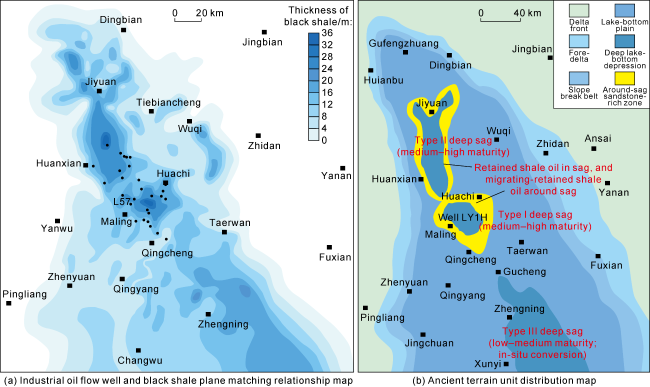Introduction
1. Geologic setting
Fig. 1. Sedimentary facies map and stratigraphic column of Chang 73 in the Ordos Basin. |
2. Classification of shale oil
Table 1. Types of Chang 73 shale oil in the Ordos Basin |
| Type | Maturity | Hydrocarbon accumulation | Thickness of sandstone layer/lamina | Reservoir | Sweet spot zone | Development method |
|---|---|---|---|---|---|---|
| Migrating- retained shale of | Medium-high maturity Ro>0.8% | Micro-migration in sandstone laminae and in situ retention in shale laminae | Single layer: 0.01-1.00 m; Large gross thickness | The silty laminae of sandy debris flow and low density turbidite flow are interbedded with deep lake shale laminae. The porosity and permeability of the silty laminae are mainly 2%-6% and (0.01-0.03)×10-3 μm2. | The zone with rich sandstone and micro-fractures, and high maturity and GOR. | Horizontal well + fracturing stimulation |
| Retained shale oil | Micro-migration in felsic and tuffaceous laminae and bedding fractures, and in-situ retention in clay and organic laminae | Micro- to nano-level | Pores in tuffaceous and felsic laminae are developed with rich free hydrocarbon, which is conducive to fracturing stimulation. Pores in organic and clay laminae are less developed with absorbed hydrocarbon, which is difficult to fracture. | Felsic black shale with high TOC, developed bedding fractures, high retained hydrocarbon content and brittle minerals. | ||
| Low-medium maturity, Ro<0.8% | In situ retention in micro-clay and organic laminae | The organic matters are mainly type I and type II1, not converted. The proportion of organic matter and retained hydrocarbon, the content of organic matter, the hydrogen index and the in situ conversion rate are high. | High TOC (>15%) Medium Ro (0.5%-0.8%) Large thickness (>15 m) Moderate depth (<2000 m) | In situ heating in horizontal wells, and hydraulic fracturing in horizontal wells for local zones with relatively high pressure and good oil-bearing property |
Fig. 2. Characteristics of shale oil in Chang 73 in the Ordos Basin. OL—organic lamina; FL—felsic lamina; CL—clay laminae. |
Fig. 3. Distribution of shale oil in Chang 7 in the Ordos Basin. |
2.1. Migratory-retained shale oil
2.2. Retained shale oil
2.2.1. Medium-high maturity retained shale oil
2.2.2. Low-medium maturity retained shale oil
Fig. 4. Composite column of Chang 73 in Well CY1 in the Ordos Basin. |
3. Geological conditions of shale oil development
3.1. Conditions of source rock
3.1.1. Source rock
Fig. 5. TOC contour map of Chang 73 black shale (modified according to Reference [33]). |
3.1.2. Maturity limit
Fig. 6. Thermal evolution model of Chang 7 source rock in the Ordos Basin. |
Fig. 7. Contour map of organic matter maturity in Chang 7 Member. |
3.2. Reservoir conditions
3.2.1. Retained shale oil reservoir
Fig. 8. Reservoir characteristics of retained shale oil in Chang 73 in the Ordos Basin. (a) Well L57, 2318.45 m, frequently developed laminae in black shale, thin-section; (b) Well CY1, 2018.71 m, scanning imaging of laminated minerals in black shale; (c) Well CY1, 2018.71 m, the laminae in shale are frequently interbedded, argon ion polishing electron microscope photo; (d) Well CY1, 2010.21 m, Intergranular pores in felsic laminae, argon ion polishing electron microscope photo; (e) Well Z9, 1329.80 m, tuffaceous lamina dissolution pores, casting thin section; (f) Well CY1, 2011.21 m, intergranular pores of clay minerals in shale, argon ion polishing electron microscope photo; (g) Well Z22, 1551.01 m, pyrite enriched in organic laminae in shale, SEM; (h) Well L57, 2334.00 m, fluorescence characteristics of different laminae in shale, fluorescent flakes. |
3.2.2. Migratory-retained shale oil reservoir
Fig. 9. Reservoir characteristics of migratory-retained shale oil in Chang 73 in the Ordos Basin. (a) Organic matter in intergranular pores in sandstone, 1640.21 m, Well Z148, common thin section; (b) intergranular pores in sandstone, 2281.86 m, Well Y297, SEM; (c) feldspar dissolution pores in sandstone, 1886.90 m, Well C37, casting thin sections; (d) feldspar erosion, 1786.20 m, Well Z204, SEM; (e) intergranular pores filled with oil in sandstone, 2021.77 m, Well CY1, common thin section; (f) sandstone in the same field of view with (e), 2021.77 m, Well CY1, fluorescent photo. |
3.3. Accumulation conditions
3.3.1. Source-reservoir pressure difference is the power for in-source hydrocarbon migration
3.3.2. Hydrocarbon generation induced fractures, bedding fractures and microfractures are high-rate channels for in-source hydrocarbon migration.
Fig. 10. Hydrocarbon generation induced fractures, bedding fractures and microfractures in Chang 73 in the Ordos Basin. (a) Hydrocarbon generation induced fracture network in organic matter laminae rich in shale, 2023.02 m, Well CY1, SEM; (b) bedding fractures in black shale, 2380.25 m, Well H36-1, core photos; (c) shale bedding surface with crude oil immersion, 2084.65 m, Well L231, core photo;(d) spillover of crude oil in high-angle fractures in siltstone, 2371.51 m, Well H36-1, core photos; (e) obvious fracture fluorescence in the same field of view with (d), core fluorescence photo; (f) siltstone fracture surface with oil immersion, 1767.40 m, Well N228, core photo. |
Fig. 11. Identification results of fracture imaging logging data in Chang 7 in Well H36-1, the Ordos Basin. |
3.3.3. The widely developed micro- and nano-pore-throat system provides space for hydrocarbon accumulation
Fig. 12. Micro-CT scanning characteristics of Chang 73 reservoir in the Ordos Basin. |
3.3.4. Hydrocarbon differentiation improves the mobility of shale oil
3.4. Brittleness
Fig. 13. Comparison of mineral components between shale with developed laminae and shale without developed laminae. (a) Black shale with frequent laminae and brittle minerals of 74.29%, Chang 73, Well N150; (b) black shale with undeveloped laminae and brittle minerals of 23.46%, Chang 73, Well N150. |
4. Exploration direction and challenges
Fig. 14. Thickness contours of black shale and distribution of paleotopographic units in Chang 73 in the Ordos Basin. |
4.1. Risk exploration of retained shale oil with medium-high maturity in deep mature sags
Fig. 15. Production test results of Chang 73 reservoir in the Ordos Basin. |
















